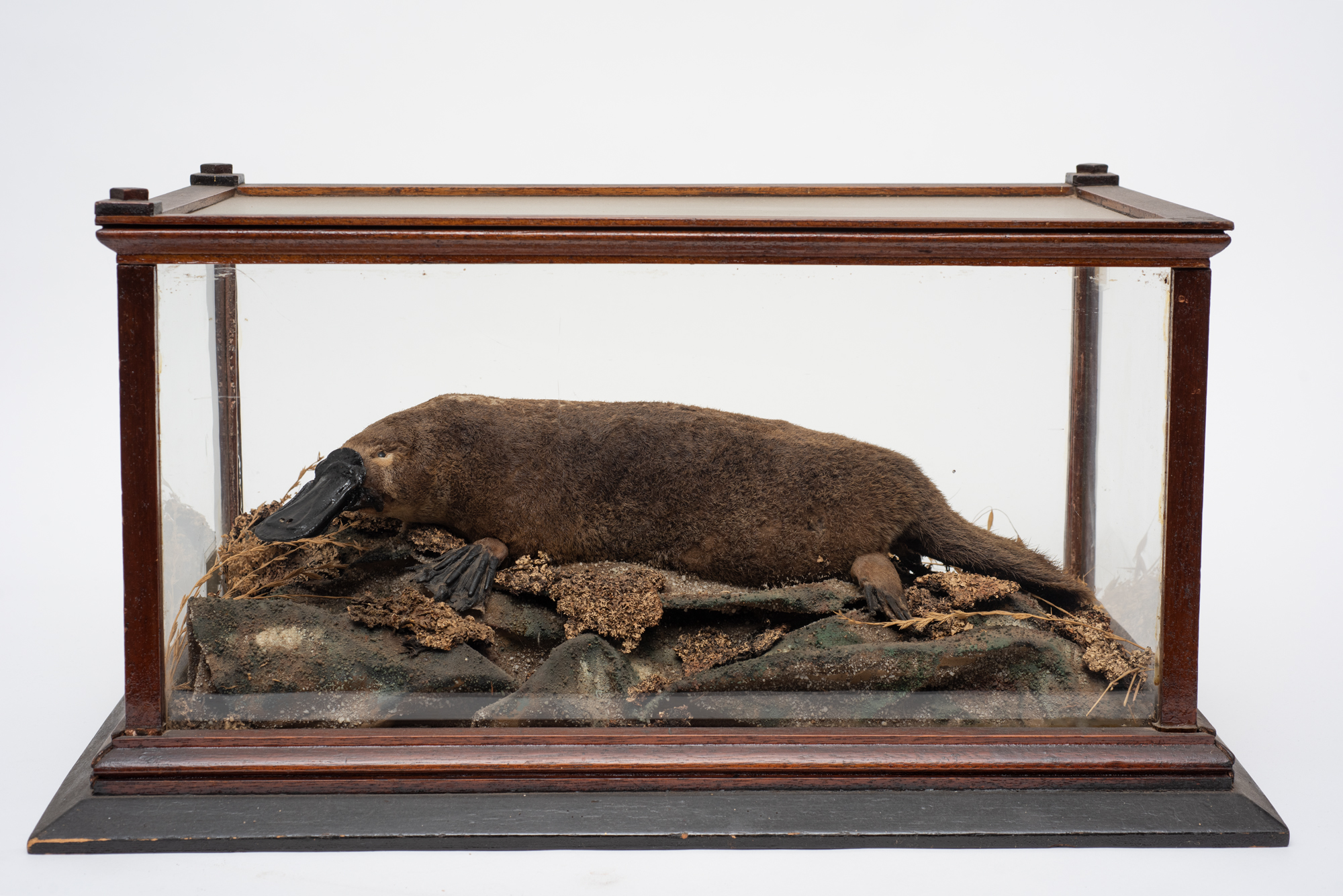Loos on Platypus
CAM's taxidermy platypus, carefully composed within a purpose-designed vitrine, draws a range of reactions from viewers. Local naturalist and writer Tanya Loos invites us to better understand the object, its history and meaning, posing some important questions about its original purpose.

When asked to write a piece honouring “our rather forlorn platypus” residing behind the scenes at the museum, I braced myself for a lumpy body, faded moth-eaten pelt, laughable platypus bill and feet, and sad glass eyes.
Instead—there it was! A perfectly preserved male platypus, with short, sleek brown fur, all skin parts intact and accurate, even down to the spurs, short and down-curved behind the “armpit” of each hind leg. He was placed on a now-faded bed of painted muslin with moss for effect, and seemed a picture of health caught in time.
This is no sad specimen but instead a fine piece of art, a carefully curated creature inside a built-for-purpose wooden and glass display box, a well-preserved example of a Victorian era cabinet of curiosities. In its day, a perfect addition to a wealthy colonialist’s sitting room.
The label is brief: shot by George Cunnack, Coliban River. Cunnack owned the local tannery, which required large amounts of wattle bark to tan the leather, so necessary for the 1870s era economy. The main wattle used was probably black wattle (Acacia mearnsii), which grows in great abundance in the region.
Like the drooping sheoak (Allocasuarina verticillata), all but removed for bakers’ ovens, even this fast-growing wattle was not enough for the demand and business of industry. This prompted Cunnack to import a new species that could be grown and used for tanning—the Valonia oak (Quercus macrolepsis). Twenty young plants were imported from London, in Wardian cases, and distributed to botanical gardens in Castlemaine, Macedon, Melbourne, Ballarat and Adelaide. Cunnack’s venture for a tanning replacement failed, as very few of the Valonia oaks planted at the Harcourt forest survived, although you can see some of these oaks growing at Winters Flat Primary School, formerly the site of Cunnack’s tannery.
Was Cunnack shooting platypus and getting them taxidermied for the wealthy as a side hustle? In Cunnack’s time, demand for items such as our platypus was likely high, as they signified social status.
And what of local regard for this extraordinary creature? During this period, platypuses were viewed by colonialists as a nuisance and regularly shot, as it was believed they ate fish eggs. By 1910, the platypus was largely extinct in larger rivers in western Victoria such as the Moorabool.
Thanks to Landcare groups and friends groups, today some of our waterways are being transformed from little more than denuded drains for industry into rich, biodiverse creeks, free of weeds and lined with wattles and eucalypts. And not before time, as the descendants of this little fellow are in strife.
A landmark report by researchers at the University of New South Wales, the Australian Conservation Foundation and WWF (World Wide Fund for Nature) Australia has called for the platypus to be listed in NSW and federally as a threatened species. At the time of writing, the Victorian government has just announced the species’s listing under the state environmental laws.
Platypus populations are hardest hit in the Murray–Darling River system. Here in the Castlemaine/Kyneton region, our platypuses are faring a little better. The Coliban River (Teeranyap in Dja Dja Wurrung language) is a tributary of the Campaspe River—and according to Melody Serena from the Platypus Conservancy, an important source of juvenile platypus.
George Cunnack’s tannery is now the site of a progressive and nature-focused primary school, the platypus appears on our coins, and the species is enjoying a funding boost and increased protection. Through caring for today’s wild platypus populations, we can avoid CAM’s lovely specimen becoming a relic of an extinct species.
Tanya Loos
January 2021